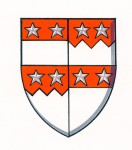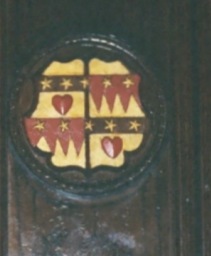|
| |
William of Lochleven, 6th Earl of Morton
 William
Douglas, 6th Earl of Morton (c.1540 - 1606) was the son of
Sir Robert Douglas of Lochleven and Margaret Erskine, a former mistress of James V of Scotland. William
Douglas, 6th Earl of Morton (c.1540 - 1606) was the son of
Sir Robert Douglas of Lochleven and Margaret Erskine, a former mistress of James V of Scotland.
Sir William's half-brother from his mother's liaison with the king was James
Stewart, Earl of Moray, Regent of Scotland from 1567 until his assassination in
January 1570. Sir William's cousin was another Regent of Scotland
James Douglas,
4th Earl of Morton, and was closely associated with him in his career, the two
men being occasionally confused in the histories.
William's father was
killed at the battle of Pinkie in September 1547. His wife was Agnes Leslie,
daughter of George Leslie, 4th Earl of Rothes, by whom he had eleven children.
The Leslies were active in Scottish Reformation.
Mary, Queen of Scots was
a prisoner in the Glassin Tower at Lochleven Castle. William Douglas was the
owner of the island Loch Leven Castle, where Mary, Queen of Scots had met John
Knox in April 1563. Since 1546, he and his mother had built the "Newhouse of Lochleven" on the shore of Loch Leven where Kinross House now stands. The
"Newhouse" eventually replaced the island castle as the centre of the estate.
William suffered from breathing difficulties all his life. After Queen
Mary's marriage to Darnley, William was commanded on 7 Nov. 1565 to deliver
Lochleven Castle to the Queen's officers with all the artillery and munitions,
but because William was "extremelie sick, in perrell of his lyffe" he was
allowed to keep the castle with the understanding that it may be taken over on
24 hours notice. William's malady must have been short lived as he was
involved in Riccio's assassination on 9 March 1566 and was formally charged for
murder on 9 March 1566.
In June 1567, Queen Mary was imprisoned in the
island castle following her surrender at the Battle of Carberry Hill. On 24 July
she was forced to sign abdication papers at Lochleven in favor of her infant son
James VI. William Douglas had a legal paper drawn up on 28 July 1567, which
stated that he was not present when the Queen signed her "demission" of the
crown and did not know of it, and that he offered to convey her to Stirling
Castle for her son's coronation which was the following day, which offer she
refused. Mary also signed that paper. However, in 1581 Mary wrote that William
was one of her few remaining enemies in Scotland, and should have witnessed that
she was compelled to assent to her resignation. The Scottish government directed
by his half-brother paid William Douglas £1,289-12d for keeping the Queen.
William's wife, Lady Agnes Leslie, became the Queen's chief female companion
during her ten and a half months of imprisonment, accompanying her throughout
the day and often sleeping in her bedchamber. Queen Mary had an opportunity of
greater liberty following the birth of Agnes's child when she was recovering
from her pregnancy. She chose to escape on 2 May 1568 from Lochleven with the
aid of Sir William's brother George and a young orphaned cousin named William
Douglas who also lived at the castle and may or may not have been the earl's
illegitimate son. When Sir William learned of his royal captive's escape, he was
so distressed that he attempted to stab himself with his own dagger.
The
title Earl of Morton was declared forfeit in 1581 when Regent Morton, the 4th
earl, was attainted; and the title was granted to John Maxwell, 7th Lord
Maxwell, a grandson of the 3rd earl. While Regent Morton was on trial in January
1581, William and other leading members of the family were not allowed to come
to Edinburgh, and in March he was ordered to live north of Cromarty. A year
later he joined in the Raid of Ruthven, and when this faction was defeated he
was exiled in France at La Rochelle, returning in 1586.
The 17th century
historian David Hume of Godscroft relates that Agnes Leslie wrote to her husband
saying she would prevent their son Robert from joining him at the Lords
Enterprisers attempt to take Stirling Castle in 1584, saying it was a foolish
work that would ruin them. William replied that their course was honourable, and
intended for the good of the church, and he trusted in providence. Robert and
their son-in-law Laurence Oliphant were banished to France despite their
mother's efforts, and were lost at sea in a battle with "Hollanders" or pirates.
In 1586, the attainder on the Morton earldom was reversed and the title
returned to the 4th earl's family. By the 4th earl's will, on the death of
Archibald Douglas, 8th Earl of Angus in 1588, William Douglas succeeded to the
earldom of Morton, which brought him additional lands and houses including
Dalkeith Palace,
Aberdour Castle,
Auchterhouse and
Drochil Castle.
Sir William's eldest son,
Robert, Master of Morton, disappeared in travel circa 1585, so the
Morton possessions devolved to Sir William's
grandson upon his death on
September 27, 1606.
|
|
 |
| Dame Mary Douglas' coat of arms from the Lairds Loft in St
Mary's Church, Cullen, Banffshire, alongside her husband's. |
See also: • The Earls of Morton
• Forfeiture papers:
'Elizabeth: May 1581', in Calendar of State Papers, Scotland: Volume 6, 1581-83'
[183kb; pdf]
Errors and Omissions
|
|
The Forum
|
|
What's new?
|
|
We are looking for your help to improve the accuracy of The Douglas
Archives.
If you spot errors, or omissions, then
please do let us know
Contributions
Many articles are stubs which would benefit from re-writing.
Can you help?
Copyright
You are not authorized to add this page or any images from this page
to Ancestry.com (or its subsidiaries) or other fee-paying sites
without our express permission and then, if given, only by including
our copyright and a URL link to the web site.
|
|
If you have met a brick wall
with your research, then posting a notice in the Douglas Archives
Forum may be the answer. Or, it may help you find the answer!
You may also be able to help others answer their queries.
Visit the
Douglas Archives Forum.
2 Minute Survey
To provide feedback on the website, please take a couple of
minutes to complete our
survey.
|
|
We try to keep everyone up to date with new entries, via our
What's New section on the
home page.
We also use
the Community
Network to keep researchers abreast of developments in the
Douglas Archives.
Help with costs
Maintaining the three sections of the site has its costs. Any
contribution the defray them is very welcome
Donate
Newsletter
Our newsletter service has been temporarily withdrawn.
|
|
|
|
|
|
|
|
|


